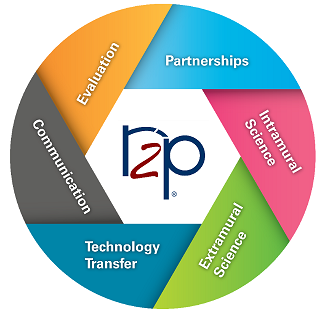RESEARCH TO PRACTICE (r2p)
About Research to Practice
Research to Practice (r2p) at NIOSH is an approach focused on the use, adoption, and adaptation of NIOSH knowledge, interventions, and technologies within the workplace. To accomplish this, NIOSH collaborates with partners and stakeholders to:
- Identify needs
- Design, plan, and conduct studies or evaluate technologies into workplace policy, procedure, technology, and/or practice
- Communicate and transfer NIOSH policy, procedure, or practices to relevant users for implementation in the workplace
- Evaluate or demonstrate the impact of these efforts on improving worker safety and health
Mission
To increase the use, adoption, and adaptation of NIOSH-generated knowledge, interventions, and technologies in practice to prevent occupational fatalities, injuries, and illnesses.
Six Core Elements for Effective Research to Practice
The NIOSH r2p approach includes six (6) core elements. Each of the elements uniquely contributes to workplace safety. The collaborations and connections between these elements leads to measurable impact and directly aligns with the mission of NIOSH.

Partnerships
A NIOSH partner is any individual, group, or organization (e.g., government, labor, academic, business, trade or professional association) whose collaborative efforts enhance NIOSH-funded research activities and help promote the movement of research into practice. Partners play key roles in activities such as: identifying occupational safety and health issues and needs; designing, planning, and conducting studies; translating and communicating research findings into policy, technology, practice, and/or information products; engaging stakeholder and practicing communities; implementing and assessing recommended work policies or practices; and evaluating or demonstrating the impact of these efforts on improving the safety and health of workers.
Intramural Science
Intramural science is conducted by researchers employed by NIOSH. For more information on NIOSH's intramural programs, visit NIOSH Programs.
Extramural Science
Extramural science is generated through funding provided by NIOSH to outside organizations. For more information on NIOSH extramural programs, visit NIOSH Extramural Research and Training Programs.
Technology Transfer
Technology transfer is the process by which knowledge, technologies, and interventions are transferred from the Government to the public or private sector.
Communication
Communication is the process through which science is translated into information products, then shared and promoted with an intended audience. NIOSH uses communication tools and strategies to create clear messages, select appropriate formats, and determine effective channels through which the information may be delivered and understood by an intended audience.
Evaluation
Evaluation is a systematic assessment of the extent to which an r2p effort meets measurable objectives, milestones, or goals. Results of evaluations may inform the planning of an effort (i.e., feasibility, or need), process (i.e., tracking), progress toward outcomes and objectives, or provide a final measure of impact.
Research to Practice Tools
At NIOSH, we use the Research to Practice Roadmap guidance document and worksheet developed by The Center for Construction Research and Training, to plan our dissemination and help facilitate the use, adoption, and adaptation of NIOSH knowledge, interventions, and technologies.
Contact
For more information about Research to Practice at NIOSH, please contact Christy Forrester at CForrester@cdc.gov or (202)245-0687.
- Page last reviewed: September 18, 2015
- Page last updated: December 4, 2015
- Content source:
- National Institute for Occupational Safety and Health Office of the Director


 ShareCompartir
ShareCompartir